Areas of Outstanding Natural Beauty Renamed National Landscapes

22nd November 2023
Areas of Outstanding Natural Beauty have been renamed as National Landscapes – in a bid to bring them in line with the importance our National Parks enjoy.
Areas of Outstanding National Beauty (AONB), as they have been known since their inception in 1949, will be elevated to National Landscapes to place them alongside their larger and more well-known counterpart National Parks, to highlight their equal place in the country’s aims around health, wellbeing, sustainable public access, climate change and nature recovery.
This is a significant milestone for the UK and the next step in fully realising the National Landscapes’ vision to be the leading exemplars of how thriving, diverse communities can work with and for nature in the UK: enhancing the beauty of the landscape, restoring ecosystems, providing food, storing carbon to mitigate the effects of climate change, safeguarding against drought and flooding, whilst also nurturing people’s health and wellbeing.
New name, new ambition
Areas of Outstanding Beauty have, perhaps because of their name, been perceived as simply ‘nice places to visit’ – but behind the name is a whole network of organisations, individuals, businesses, government policies, agendas, reviews, frameworks and research, directing how this valuable landscape can be conserved and enhanced well and used better, to achieve national targets around people’s health and well being, climate management and nature recovery. People, Place, Climate and Nature are the stables under which all plans are housed.
Kent Downs, which covers 25% of Kent, is a key land area for the county, and enchanting landscape closely linked to tourism, the diverse rural economy, nature, health, wellbeing and even the water we drink. It spans coastlines, farmland, woodland – 900km2 all told, across 12 local authority areas – these council bodies providing key partnerships in nurturing, developing and prospering from the land whilst improving it over declining it.
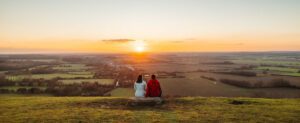
Water
75% of Kent’s drinking water comes from the chalk aquifer of the Downs, with most catchments either over licenced or over abstracted already. the SE alone is expected to account for around 50% of all the UK’s future need for public water supplies, which brings a huge opportunity for the Kent Downs National Landscape to work with the water companies and regulators on ambitious, nature and landscape-led projects and solutions around management of the water environment.
Soil and land
More high-grade agricultural soils in Kent, means more arable growing than most other National Landscapes, creating a greater need and opportunity to promote and deliver low carbon farming practices, approaches which also support aquifer recharge and allow the nationally significant collections of rare arable wildflowers to flourish. There are orchids and butterflies, moths, beetles and bugs that prosper in the Kent Downs and remain largely unseen in other parts of England. Habitat restoration is a key element. Our chalk grasslands are likened by many to the UK equivalent of the tropical rainforests.
Viticulture
Kent Downs has the highest concentration of vineyards in the UK – a Champagne house has already planted substantially in the Kent Downs, owing to its similar ‘terroir’ to the French Champagne region. Viticuture is a thriving and energetic part of the rural economy, there are great opportunities to ensure this new energy brings with it new nature, new jobs and more beautiful landscapes.
Woodland
The Kent Downs is one of Britain’s most wooded landscapes (23% woodland) and the majority of this is irreplaceable ancient woodland (70%) home to some of our most valuable and threatened wildlife and enjoying an economic resurgence.
Economy
The beauty of the Kentish National Landscape is a major driver of our visitor economy. Post-pandemic, tourism in the Kent Downs recovered quicker than the rest of Kent.
- 8.6 million visitors, a mix of days and stays.
- Spent £379 million, only 15% less than pre-pandemic levels and 47% up on 2020.
- Supported nearly 8,255 FTE jobs.
Sustainable access
Improving access is a key aspect of the future plans of the newly-named Kent Downs National Landscape. Local people must enjoy what’s on their doorstep and tourism must be encouraged – without being detrimental to the landscape and nature they are visiting. Many projects are already in place to encourage local visits, UK tourism, overseas tourism, working with and supporting local businesses, providers and land owners, to create places to visit and stay within the National Landscape.
Health & wellbeing
Landscape and nature can bring deep joy – the health benefits are well researched, proven and documented. Who doesn’t feel better after filling the lungs with fresh air, clearing their mind, spotting a bird, hearing the leaves rustle and reconnecting with nature? The pandemic highlighted the enjoyment nature can bring – when everything else was stripped back, it was nature that many of us turned to and enjoyed. An aspect of the new name will be continuing to push the benefits of enjoying what nature has provided.
Green recovery
The original aim of AONBs when they were set up more than 70 years ago, was to preserve the UK’s finest landscapes and promote enjoyment. This developed into conserving, enhancing, and now, recovery is also a sad but much-needed ingredient. There is a movement to actively rest, renew and rather than conserve what we have. There is a constant balance to be made between encouraging tourism which boost the local economy, with the tolerances of nature and landscapes that provide the opportunities.
Climate change
National Landscapes have a big part to play in the fight against turning the tide on climate change. Change being the key word – using land differently, looking to new practices to manage it, produce from it and reduce environmental impact. Projects across Kent’s National Landscape also address flooding through defence, land management and water storage. Hedgerows and tress are being planted, and projects to sequester carbon begun.
Farming
The Farming in Protected Landscapes project provides a formal support link to farmers, landowners and land managers within the designated AONB, now National Landscapes areas. Launched in 2021, it’s an easy to apply grant programme to support the pillars of People, Place, Climate and Nature for farmers, land managers and community groups. Since 2021, £1,372,431 has been awarded across 49 projects from a total project fund of £1,723,583 and £1m further is already secured for next year. The Kent Downs Farming in Protected Landscapes programme is funded by Defra.
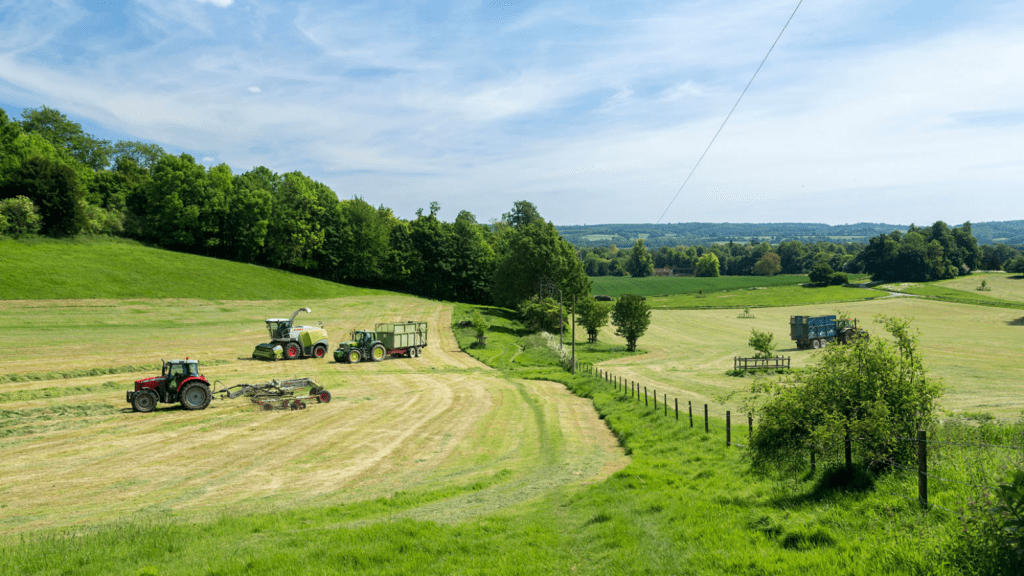
Big plans
Work is already under way across Kent, with more planned – here’s a snapshot of projects large, small, regional and national.
- Putting Downs Routes project: We have been awarded a £250,000 grant by The National Lottery Heritage Fund to improve physical access and Equity, Diversity and Inclusion on the North Downs Way National Trail to make it more accessible to more people. The North Downs Way is one of only 16 designated National Trails in England and Wales. Passing through 153 miles of stunning and diverse landscapes and through the protected landscapes of the Surrey Hills and Kent Downs National Landscapes.
- Darent Valley: Investment of £87,950 on path and gate improvements, scrub clearance and resurfacing, along with the creation of a new Darent Valley app to help people to find and enjoy routes, listening to facts about the landscape; development of 17 new rail to trail walks, and the production and distribution of rail trail packs and valley leaflets to reach new audiences.
- Delivering more than £2m of Farming in Protected Landscapes projects by March 2025 including several ambitious regenerative agriculture projects.
- Applying to UNESCO for Global Geopark Status by November 2024 supported by more than £400K investment in Geosites, community engagement, landscape festivals and promotion.
- Securing a new Super National Nature Reserve covering over 2000Ha (nearly 5,000 acres) in the Cobham and Shorne area by the end of 2025.
- Involving schools and communities through wide ranging engagement events and activities across the landscape.
- Securing more than £500K of new access improvements across the AONB by the end of 2025.
- Supporting and providing positive professional planning advice to our local authority partners throughout their Local Plan preparation and development management roles.
- Doubling our business and community ambassador programme to more than 80 Kent Downs businesses.
- Leading the BIG CHALK programme – a colossal regional nature recovery plan.
- Delivering the £3.2m Darent Valley Landscape Partnership Scheme by the end of 2024.
- Developing a new, £multi-million bid to National Lottery Heritage fund under their new strategic framework.
- Engaging with Government to secure a positive future and fair investment in this most special part on England.
The name may have changed, but the work goes on, against a backdrop of climate threat, to secure Kent’s landscapes, nature, wildlife and outstanding beauty for generations to come.
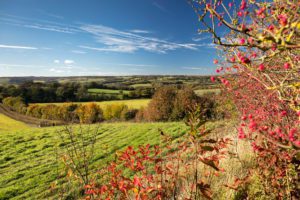
National Landscapes – the bigger picture across England, Wales and Northern Ireland
By 2030, National Landscapes aim that, within their boundaries:
- At least 200,000 hectares of the most valuable natural areas (Sites of Special Scientific Interest or SSSIs), which equates to 1.25 times the size of London, will be in favourable condition.
- 100,000 hectares of wildlife-rich habitat outside of SSSIs will be created or restored, which is twice the size of Cornwall 36,000 hectares of woodland, which is a little smaller than the Isle of Wight, will have been planted or allowed to regenerate.
- National Landscapes partnerships will also focus on habitat restoration to ensure the protection of some of our most endangered species and increase their work to help more people to enjoy time spent in beautiful places.
Because of their size and scope, National Landscapes are ideally positioned to address the environmental issues the UK is facing. There are 46 AONBs in the UK, covering 14% of England, Wales and Northern Ireland including moorland, farmland, coast, forests, and include UNESCO World Heritage Sites, Biosphere Reserves, a Geopark and International Dark Sky Reserves. They are the UK’s nearby countryside – 66% of people in England (44 million) live within 30 minutes of an AONB, and at least 170 million people visit them every year.
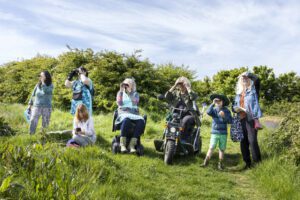
Nick Johannsen, Director of Kent Downs National Landscapes says:
“Here in the Kent Downs, we are excited by the new energy which will follow the new branding. We are determined this will be much more than a change of name, indeed the whole network of National Landscapes are using this change as a platform for renewal, for us, here in the Kent Downs this means strengthening our mission to conserve and enhance the extraordinary natural beauty of this enchanting quarter of Kent.
The Kent Downs National Landscape will renew and widen our engagement and welcome to the millions of people who care for and enjoy the Kent Downs so more benefit, to make sure this unique place remains beautiful, distinct and characteristic, to ensure the landscape contributes its part to responding to the climate emergency and renew and recover the nature which relies on the Downs. We have a strong and supportive local partnership joining and supporting the journey.
Our mission is to conserve and enhance the natural beauty of the Kent Downs, we will drive this through the themes of People, Place, Climate and Nature which now form the core of our work. We warmly invite everyone to join this vital mission – if you can, get out and see what’s on your doorstep, support the businesses working with us, think about your choices in relation to climate change and do what you can for the nature and wildlife near you.
“Most of all, enjoy what we have in Kent – it’s special, unique and well worth a visit.”
Tony Juniper, Chair of Natural England says:
“For decades the AONBs have helped protect the beauty of our finest landscapes. Today though we need so much more from these wonderful places, helping us adapt to climate change, catching carbon, restoring depleted wildlife and encouraging more people outside, at the same time as producing food, sustaining local communities and enhancing historic environments.
“Modern challenges require new approaches and today marks the beginning of a new phase for our National Landscapes, as they strengthen their existing partnerships, and forge new ones that will secure in perpetuity the huge range of benefits that come from these special places. Big change has taken place during the past 75 years and bigger changes still can be expected during the decades ahead. Uniting the National Landscapes in this way is very welcome and spells immense opportunity and great hope for the future.”
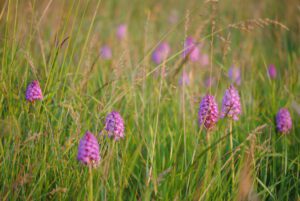
Popular articles
The Best Viewpoints in the Kent Downs
Searching for incredible views? Look no further! We've rounded up the best…
Top 5 bluebell walks in the Kent Downs
If you're looking for inspiration on the best places for some bluebell…
Lambing season in the Kent Downs
Discover the importance of lambing season in the Kent Downs and find…
